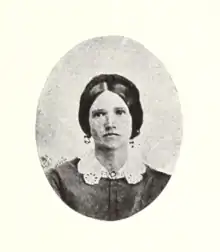Frances Eliza Babbitt
Frances "Franc" Eliza Babbitt (1824–1891) was a schoolteacher in Minnesota and an archaeologist. She influenced early debates about the Paleolithic Era in North America, the "American Paleolithic". Babbitt collected quartz tools and other artifacts from the Little Falls, Minnesota area. Her findings were presented in papers at American Association for the Advancement of Science (AAAS) meetings and in academic journals. Although women were active in other scientific disciplines during this time, Babbitt was one of few to participate in archaeology.[1]
Frances "Franc" Eliza Babbitt | |
|---|---|
 | |
| Born | January 24, 1824 New York, U.S. |
| Died | July 6, 1891 (aged 67) |
| Resting place | Coldwater, Michigan |
| Occupation(s) | Teacher, Archaeologist |
Early life
Babbitt was born in New York on January 24, 1824, and became a schoolteacher at the age of 20. In 1873, she moved to Cold Water, Michigan. A few years later, in 1878, she moved to Little Falls, Minnesota.[2][3]
Career
Babbitt worked as a schoolteacher, but was an active amateur archaeologist. She also spent time at the local Ojibwe Indian reservation. Some of her articles were based on observations she made while working with indigenous people.[1]
In 1879, Babbitt found thousands of quartz objects on the east bank of the Mississippi River. The objects were exposed in a washout and a wagon rut that cut 15 feet below the surrounding ground surface. Babbitt communicated her finds to archaeologists and other scientists, including Alexander Newton Winchell, Frederic W. Putnam, Warren Upham, Charles Abbott, Henry W. Haynes, Charles Rau, and Otis Mason. They were first presented at the Department of American History at the Minnesota Historical Society in St. Paul, in February 1880. In 1883, Babbitt worked with Warren Upham to prepare a paper on her findings for the annual meeting of the AAAS, held that year in Minneapolis. The paper was subsequently published in the Proceedings of the meeting. In the paper, Babbitt held that humans had created the quartz objects and that they had not been disturbed or moved. The quartz objects Babbitt found were also presented at the AAAS meeting in Philadelphia in 1884. She wrote descriptions of them and they were subject of debates about the history of human activities during the Ice Age on the American continent.[1] The next year, she wrote an article about her evidence for "glacial man" in Minnesota for the American Naturalist.[3]
Some archaeologists, including William H. Holmes, opposed the findings of Babbitt and her coauthors, arguing that the objects were more modern and were rejects from a quarry. Holmes's objections to Babbitt's findings also focused on the credentials of Babbitt and her collaborators. The debate about the "Babbitt finds" continued into the 1890s after she died.[1] The findings have since been demonstrated to be "naturefacts", quartz objects created by natural processes.[2]
With the support of Frederic W. Putnam, Babbitt was one of the first women to join the AAAS (1883)[4] and became a fellow of the society in 1887.[2] She also provided a manuscript list giving the geographical range of several plant species that Warren Upham used to produce a catalogue of Minnesota's flora.[5]
Babbitt died on July 6, 1891, and is buried in a family plot in Coldwater, Michigan. A relative "disposed" of her collection of quartz objects after her death.[6]
Selected works
- Red Lake Notes, 1881[7]
- Vestiges of Glacial Man in Minnesota, 1884[8]
- Exhibition and Description of Some Paleolithic Quartz Implements from Central Minnesota, 1884.[9]
- Indian Implements of the Northwest, 1884[10]
- Some Implements of the Minnesota Ojibwas, 1884[11]
- Some Ojibwa and Dakota Practices, 1886[12]
- Lake Itasca, 1887[13]
References
- Chester, Hillary Lynn (2002). "Frances Eliza Babbitt and the Growth of Professionalism of Women in Archaeology". muse.jhu.edu. Retrieved 2023-01-08.
- Browman, David L. (2020-02-17). Cultural Negotiations: The Role of Women in the Founding of Americanist Archaeology. U of Nebraska Press. ISBN 978-1-4962-1044-9.
- Jenks, A.E. (1935). Recent discoveries in Minnesota prehistory. Minnesota History 16(1). http://collections.mnhs.org/MNHistoryMagazine/articles/16/v16i01p001-021.pdf
- Browman, David L. (June 2002). "The Peabody Museum, Frederic W. Putnam, and the Rise of U.S. Anthropology, 1866–1903". American Anthropologist. 104 (2): 508–519. doi:10.1525/aa.2002.104.2.508. ISSN 0002-7294.
- Upham, Warren (1884). Catalogue of the flora of Minnesota : including its phænogamous and vascular cryptogamous plants, indigenous, naturalized, and adventive. Minneapolis: Johnson, Smith & Harrison. p. 10.
- J., Ann Marie (2008-07-02). "Morrison County Influentials: 36–40". Morrison County Historical Society. Retrieved 2023-01-08.
- Babbitt, Franc (1881-01-01). "Red Lake Notes". Journal of the Minnesota Academy of Science. 2 (3): 86–101. ISSN 0026-539X.
- Babbitt, Franc E. (July 1884). "Vestiges of Glacial Man in Minnesota". The American Naturalist. 18 (7): 697–708. doi:10.1086/273712. ISSN 0003-0147. S2CID 83927583.
- Babbitt, Frances Eliza (1884). Exhibition and Description of Some Paleolithic Quartz Implements from Central Minnesota. American Association for the Advancement of Science.
- Babbitt, Franc E. (1884-05-16). "Indian Implements of the Northwest". Science. ns-3 (67): 589–590. Bibcode:1884Sci.....3..589B. doi:10.1126/science.ns-3.67.589. ISSN 0036-8075. PMID 17738946.
- Babbitt, Franc E. (1884-12-12). "Some Implements of the Minnesota Ojibwas". Science. ns-4 (97): 527–529. Bibcode:1884Sci.....4..527B. doi:10.1126/science.ns-4.97.527. ISSN 0036-8075. PMID 17773554.
- Babbitt, Franc E. (1886-06-11). "Some Ojibwa and Dakota Practices". Science. ns-7 (175): 526–528. Bibcode:1886Sci.....7..526B. doi:10.1126/science.ns-7.175.526. ISSN 0036-8075. PMID 17807260.
- Babbitt, Franc E. (1887-08-05). "Lake Itasca". Science. ns-10 (235): 72. doi:10.1126/science.ns-10.235.72.f. ISSN 0036-8075.